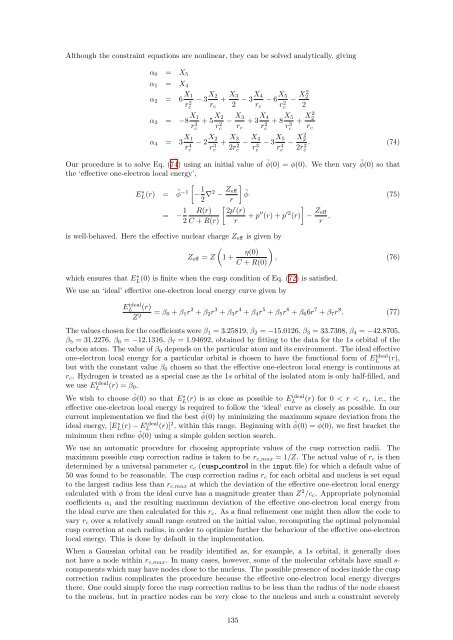CASINO manual - Theory of Condensed Matter
CASINO manual - Theory of Condensed Matter
CASINO manual - Theory of Condensed Matter
Create successful ePaper yourself
Turn your PDF publications into a flip-book with our unique Google optimized e-Paper software.
Although the constraint equations are nonlinear, they can be solved analytically, giving<br />
α 0 = X 5<br />
α 1 = X 4<br />
α 2 = 6 X 1<br />
r 2 c<br />
α 3 = −8 X 1<br />
r 3 c<br />
α 4 = 3 X 1<br />
r 4 c<br />
− 3 X 2<br />
+ X 3<br />
r c 2 − 3X 4<br />
− 6 X 5<br />
r c rc<br />
2 − X2 2<br />
2<br />
+ 5 X 2<br />
r 2 c<br />
− 2 X 2<br />
r 3 c<br />
− X 3<br />
+ 3 X 4<br />
r c rc<br />
2 + 8 X 5<br />
rc<br />
3 + X2 2<br />
r c<br />
+ X 3<br />
2r 2 c<br />
− X 4<br />
r 3 c<br />
− 3 X 5<br />
r 4 c<br />
− X2 2<br />
2rc<br />
2 . (74)<br />
Our procedure is to solve Eq. (74) using an initial value <strong>of</strong> ˜φ(0) = φ(0). We then vary ˜φ(0) so that<br />
the ‘effective one-electron local energy’,<br />
[<br />
EL(r) s = ˜φ −1 − 1 2 ∇2 − Z ]<br />
eff ˜φ (75)<br />
r<br />
= − 1 [<br />
R(r) 2p ′ ]<br />
(r)<br />
+ p ′′ (r) + p ′2 (r) − Z eff<br />
2 C + R(r) r<br />
r ,<br />
is well-behaved. Here the effective nuclear charge Z eff is given by<br />
(<br />
Z eff = Z 1 + η(0) )<br />
, (76)<br />
C + R(0)<br />
which ensures that EL s (0) is finite when the cusp condition <strong>of</strong> Eq. (72) is satisfied.<br />
We use an ‘ideal’ effective one-electron local energy curve given by<br />
EL<br />
ideal (r)<br />
Z 2 = β 0 + β 1 r 2 + β 2 r 3 + β 3 r 4 + β 4 r 5 + β 5 r 6 + β 6 6r 7 + β 7 r 8 . (77)<br />
The values chosen for the coefficients were β 1 = 3.25819, β 2 = −15.0126, β 3 = 33.7308, β 4 = −42.8705,<br />
β 5 = 31.2276, β 6 = −12.1316, β 7 = 1.94692, obtained by fitting to the data for the 1s orbital <strong>of</strong> the<br />
carbon atom. The value <strong>of</strong> β 0 depends on the particular atom and its environment. The ideal effective<br />
one-electron local energy for a particular orbital is chosen to have the functional form <strong>of</strong> EL<br />
ideal (r),<br />
but with the constant value β 0 chosen so that the effective one-electron local energy is continuous at<br />
r c . Hydrogen is treated as a special case as the 1s orbital <strong>of</strong> the isolated atom is only half-filled, and<br />
we use EL ideal (r) = β 0 .<br />
We wish to choose ˜φ(0) so that EL s (r) is as close as possible to Eideal L (r) for 0 < r < r c , i.e., the<br />
effective one-electron local energy is required to follow the ‘ideal’ curve as closely as possible. In our<br />
current implementation we find the best ˜φ(0) by minimizing the maximum square deviation from the<br />
ideal energy, [EL s (r) − Eideal L (r)] 2 , within this range. Beginning with ˜φ(0) = φ(0), we first bracket the<br />
minimum then refine ˜φ(0) using a simple golden section search.<br />
We use an automatic procedure for choosing appropriate values <strong>of</strong> the cusp correction radii. The<br />
maximum possible cusp correction radius is taken to be r c,max = 1/Z. The actual value <strong>of</strong> r c is then<br />
determined by a universal parameter c c (cusp control in the input file) for which a default value <strong>of</strong><br />
50 was found to be reasonable. The cusp correction radius r c for each orbital and nucleus is set equal<br />
to the largest radius less than r c,max at which the deviation <strong>of</strong> the effective one-electron local energy<br />
calculated with φ from the ideal curve has a magnitude greater than Z 2 /c c . Appropriate polynomial<br />
coefficients α i and the resulting maximum deviation <strong>of</strong> the effective one-electron local energy from<br />
the ideal curve are then calculated for this r c . As a final refinement one might then allow the code to<br />
vary r c over a relatively small range centred on the initial value, recomputing the optimal polynomial<br />
cusp correction at each radius, in order to optimize further the behaviour <strong>of</strong> the effective one-electron<br />
local energy. This is done by default in the implementation.<br />
When a Gaussian orbital can be readily identified as, for example, a 1s orbital, it generally does<br />
not have a node within r c,max . In many cases, however, some <strong>of</strong> the molecular orbitals have small s-<br />
components which may have nodes close to the nucleus. The possible presence <strong>of</strong> nodes inside the cusp<br />
correction radius complicates the procedure because the effective one-electron local energy diverges<br />
there. One could simply force the cusp correction radius to be less than the radius <strong>of</strong> the node closest<br />
to the nucleus, but in practice nodes can be very close to the nucleus and such a constraint severely<br />
135

















